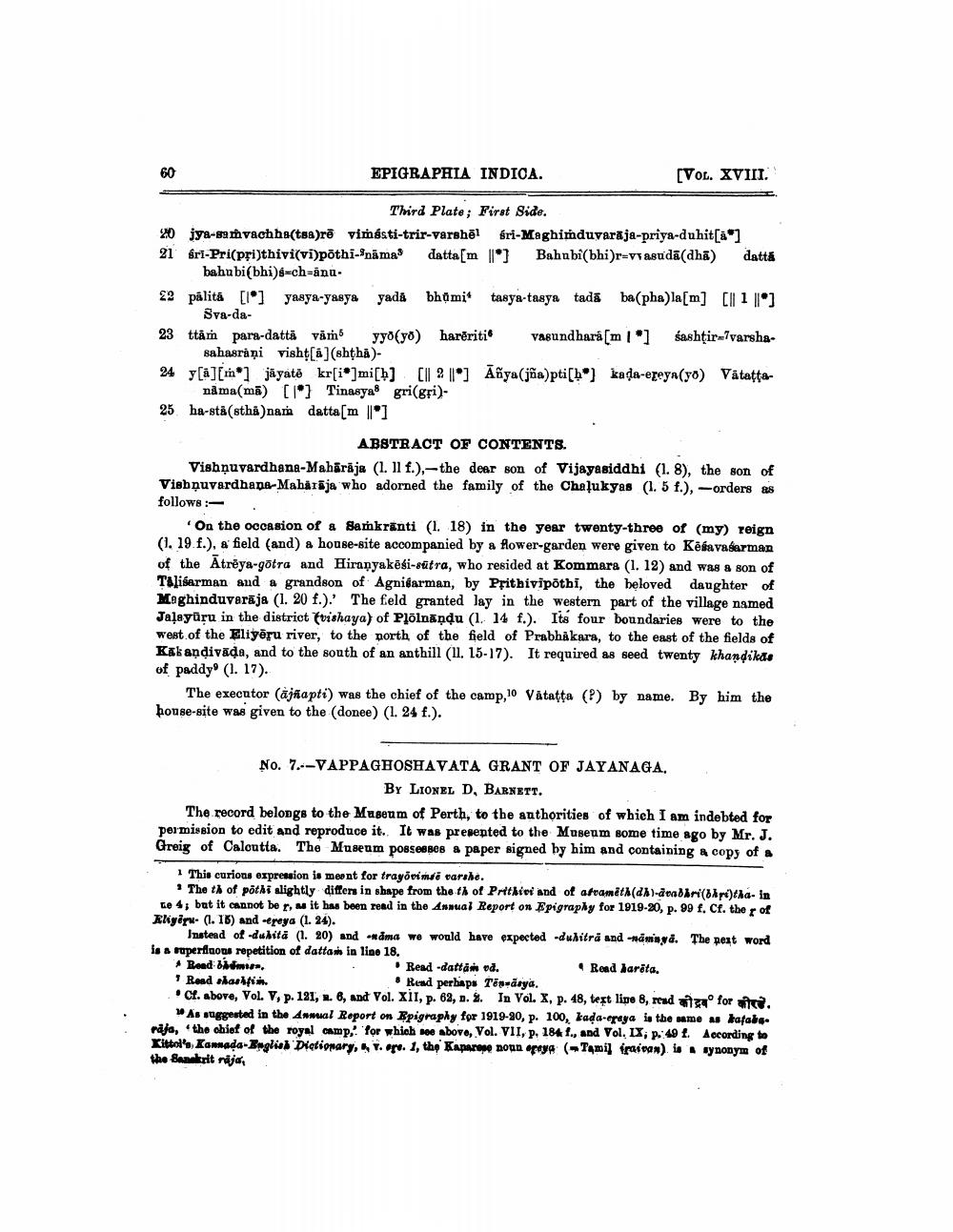________________
EPIGRAPHIA INDICA.
(VOL. XVII.
Third Plate; First Side. 20 jya-samvachhatsa)rē vimgsti-trir-varshēl sri-Maghimduvaraja-priya-duhit[a] 21 Srl-Pri(prijthivi(vi)pöthi-Snima datta[m 1 Bahubi(bhi)r-Vasudā(dha) datta
bahubi(bhi)s-ch=ana. 22 pâlită [lo] yasya-yasya yad bhimi tasya-tasya tada ba(pha)la[m] [ 1 ||']
Bra-da
23 ttam para-datta vär y yd(yo) harēriti vasundhara[m ] śashtir-Ivarsha
sahasråņi visht[] (shthå)24 y[a][mn] jäyatë kr[i*]mi[b] [ll 2 |*] Āöya(jña) pti[b') kada-ereya(yo) Vätatta
nåma(mā) [1] Tinasya gri(gri)25 ha-stä(stha)namin datta[m M']
ABSTRACT OF CONTENTS. Vishnuvardhana-Mahārāja (1. 11 f.),-the deer son of Vijayasiddhi (1.8), the son of Visbņuvardhana-Maharaja who adorned the family of the Chalukyas (1.5 f.), -orders as follows:
On the occasion of a Samkrānti (1. 18) in the year twenty-three of (my) reign (1. 19.f.), a field (and) a house-site accompanied by a flower-garden were given to Kēšavasarman of the Ātrêya-gotra and Hiranyakēsi-sütra, who resided at Kommara (1. 12) and was a son of Talisarman and a grandson of Agnisarman, by Prithivipõtbi, the beloved daughter of Maghinduvarāja (1. 20 f.). The feld granted lay in the western part of the village named Jaļayūru in the district (vishaya) of Plölnandu (1. 14 f.). Its four boundaries were to the west of the Eliyēru river, to the north of the field of Prabhakara, to the east of the fields of Kakaņdivāda, and to the south of an anthill (11. 15-17). It required as seed twenty khandikas of paddy' (1. 17).
The executor (ājñapti) was the chief of the camp, 10 Våtatta (?) by name. By him the house-site was given to the (donee) (1.24 f.).
No. 7.--VAPPAGHOSHAVATA GRANT OF JAYANAGA,
BY LIONEL D, BARNETT. The record belongs to the Museum of Perth, to the authorities of which I am indebted for permission to edit and reproduce it. It was presented to the Museum some time ago by Mr. J. Greig of Caloutta. The Museum possesses a paper signed by him and containing a copy of a
This curious expression is meant for trayövimi tarehe. · The th of pothi slightly differs in shape from the th of Prithio and of a tramith(dl)-deadhri(Ikrétha- in te 4; but it cannot be r, it has been read in the Annual Report on Epigraphy for 1919-20, p. 99 f. Cf. the of Eligögw- (1.16) and -ereya (1. 24).
Instead of -dukita (i. 20) and #ama we would have expected -duhitra and naming. The peat word is a ruperilaous repetition of datta in line 18. * Read mos. . Read -dattan od.
Read harëta. Read shashtin
. Read perhaps Tērsāsya. . Cf. above, Vol. V, p. 121, . 6, and Vol. XII, p. 62, n. 3. In Vol. X, p. 48, text lipe 8, rond 34° for .
As suggested in the Annual Report on Epigraphy for 1919-20, p. 100, kada-saya in the same na batabe ndja, the chief of the royal camp, for which we above, Vol. VII, p. 184 f., and Vol. IX, p. 49 . According to Kittol's Kannada-English Dictionary, 1. o. 1, the Kaparose noun sroya (Tamil fraivan) synonym of the Sekrit nija




